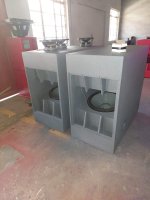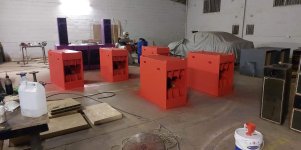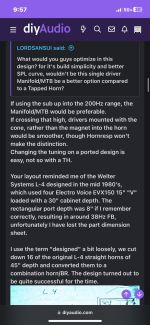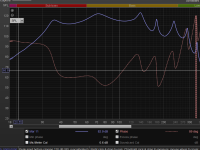Yeah, the stuff we can create where the bandwidth is gonna end at 80-100 hz and there aren’t any other 1/4 wave resonances until ~200hz (and a big ‘quiet’ gap of full wave length /cancelation is intentionally created, by design, as an advantage) ?
Last edited:
can we use Brian Steele spreadsheets with this ?
what spreadsheet
https://www.diysubwoofers.org/sheets/

what spreadsheet
https://www.diysubwoofers.org/sheets/
I thought the whole point of the parallel (3:1) 1/4 wave, or Helmholtz with little compound ‘horn’ designs (or 1/3 offset driver varieties of TL) is to avoid the disaster @ 3 x Fb in those things and all that ringing and junk that doesn't get along with your other speakers?
This isn’t a useful subwoofer(compared to the others)? . The results of that ‘5/4’ and ‘7/4’ resonance are simply too nasty to bother with trying to eliminate/crossover through and the lower resonances might be a bit ‘overdamped’? The problem is the ‘high compression ratio’ and long skinny pipe relative to the motor force?
The graph you chose does is not a parallel (3:1) 1/4 wave or has a high compression ratio.
The graph is a positive flare TH.
(Sd) 855cm2 / (S2) 378.99cm2 = a 2.26 to 1 compression ratio.
I think that’s the point?
Your (tapped pipe/horn) designs consistently present chaos to the crossover region where the other designs in this ‘manifold’ or similar compound horn/helmholtz resonator ’ so easily avoid that because they’re ‘shorter’, but load the other side of the driver and increase the output everywhere in the babdwidth (like a paraflex but much easier to drive)
Your (tapped pipe/horn) designs consistently present chaos to the crossover region where the other designs in this ‘manifold’ or similar compound horn/helmholtz resonator ’ so easily avoid that because they’re ‘shorter’, but load the other side of the driver and increase the output everywhere in the babdwidth (like a paraflex but much easier to drive)
Attachments
can we use Brian Steele spreadsheets with this ?
what spreadsheet
https://www.diysubwoofers.org/sheets/
View attachment 1466689
Based on a MTHALT fold on my phone:
274.36cm / 2.54cm = 108in (or 9ft).
Internal height = 108in / 4 segments = 27in.
Internal width & segment depth = 711.29cm2 = 2.54cm^2 × 7in depth x 15.75in width.
External height = 27in + 2.25in = 29.25in.
External width = 15.75in + 1.5in = 17.25in.
External depth = 7in x 4 segments + 3in = 31in.
I think that’s the point?
High compression ratios (>3:1) create high air speeds (>17m/s) or port noise.
YOUR crossover regions causes problems.
With my BP6S', my highest low pass filter would be 100hz. It's a SUBwoofer, not a bass bin.
Definitely poison.Pick your poison.
Those look like the antithesis to the Manifold configuration discussed here - the appeal of the horn assisted BP6 is to push the usable bandwidth higher and avoid the gack of cancellations that TH generate... which can offer smoother integration and other advantages especially relevant for P.A use
Instead you're presenting tapped horns with +10db of noise, and I can't understand why they're being shared in this discussion
High compression ratios (>3:1) create high air speeds (>17m/s) or port noise.
YOUR crossover regions causes problems.
With my BP6S', my highest low pass filter would be 100hz. It's a SUBwoofer, not a bass bin.
Again, your ‘magic’ filter isn’t going to help the REAL issues with your designs. You need to build these things and listen to them so your ‘opinions’ and suggestions are somehow integrated with the ‘noise’ everyone is trying to avoid in this thread specifically about this?
The shorter low tuned resonator shapes (and a potential driver offset position) are preventing so much of the junk you’re slinging like bad drugs 😝
Your ‘bass bins’ make goofy noises that nobody is addicted to
What about a type C or O paraflexInstead you're presenting tapped horns with +10db of noise, and I can't understand why they're being shared in this discussion
Are those ranked as manifold?
Ok, so that means that the TH18, the SS15, the keystone and the danley TH series sound like crap cause the gack of cancellations a TH generates,Definitely poison.
Those look like the antithesis to the Manifold configuration discussed here - the appeal of the horn assisted BP6 is to push the usable bandwidth higher and avoid the gack of cancellations that TH generate...
if that is true , why people make em and use em and in the case of danley pay premium for the cabinets and deploy them.
so, i must stay away from TH designs ? and better use a BR or a BP ?
I don’t know how anyone can listen to a ‘tapped horn’ if the top of the bandwidth (and crossover region) is absolute chaos where vocals will howl/ring/linger, As well as the harmonics and details of bass Instruments ?
Art, recommends other designs if using the subwoofer into those frequencies at the start of the thread.
Don’t Danley products come with a pre-program, DSP and crossover?
Just use two drivers in two big vented reflex designs and avoid all of this ? (Add a short horn to the other side if you want ? It won’t have the chaos @ 3 x Fb that a tapped pipe/horn creates)
Art, recommends other designs if using the subwoofer into those frequencies at the start of the thread.
Don’t Danley products come with a pre-program, DSP and crossover?
Just use two drivers in two big vented reflex designs and avoid all of this ? (Add a short horn to the other side if you want ? It won’t have the chaos @ 3 x Fb that a tapped pipe/horn creates)
Attachments
Last edited:
Build and listen to a BP6S. The positive acoustic feedback has a lot of advantages that is not shown by simple Hornresp sim.and very seldom have I found a driver that performs better in a BP6S than it does in a BP6P
Here is a ChatGPT description of what I mean:
Positive acoustic feedback in a series-tuned bandpass enclosure occurs when a portion of the output signal is fed back to the input via an acoustic feedback loop, with appropriate phase and delay, thereby reinforcing the incoming signal within the tuned frequency band. Due to the inherently exponential nature of positive feedback—where each amplification cycle increases amplitude, which in turn is further amplified in subsequent cycles—this feedback acts as a weakly exponential compensation for dynamic compression in the loudspeaker driver.
Dynamic compression, manifested at high sound pressure levels, reduces the effective sensitivity and linearity of the driver’s diaphragm motion. Through the exponential self-overlaying characteristic of positive feedback, a localized gain enhancement is generated that counteracts this compression by actively reintroducing energy into the system, effectively maintaining or increasing sensitivity within the bandpass frequency range.
From a technical standpoint, this process can be modeled as a self-reinforcing amplification where the amplitude follows a geometric progression, allowing the system to sustain a more stable output level despite the driver’s nonlinear dynamic response. Careful control of the feedback magnitude is critical to avoid instability or oscillation. Thus, positive acoustic feedback in a series-tuned bandpass enclosure can be implemented as an implicit dynamic compression compensation mechanism leveraging its intrinsic exponential behavior.
Are you calling the ringing or increased upper group delay shown in a Hornresp sim (or actual measurements) "positive acoustic feedback" ?Build and listen to a BP6S. The positive acoustic feedback has a lot of advantages that is not shown by simple Hornresp sim.
If not, what specifically in a "BP6S" are you saying provides "positive acoustic feedback" advantages?
according to the pic, mid 1980's a BR/HORN was designed and sounded pretty goodI don’t know how anyone can listen to a ‘tapped horn’ if the top of the bandwidth (and crossover region) is absolute chaos where vocals will howl/ring/linger, As well as the harmonics and details of bass Instruments ?
Art, recommends other designs if using the subwoofer into those frequencies at the start of the thread.
Don’t Danley products come with a pre-program, DSP and crossover?
Just use two drivers in two big vented reflex designs and avoid all of this ? (Add a short horn to the other side if you want ? It won’t have the chaos @ 3 x Fb that a tapped pipe/horn creates)
where are those plans ? and theory behind them
Positive acoustic feedback in a series-tuned bandpass enclosure inherently exhibits a nonlinear, exponential characteristic that fundamentally distinguishes it from mere passive resonance phenomena such as ringing or increased group delay. While it is true that the presence of positive feedback inevitably produces observable effects like ringing and elevated group delay in the upper portion of the passband—where the feedback mechanism is active—focusing solely on these manifestations is akin to dismissing the Lockheed SR-71 Blackbird as a poor aircraft based on the intense turbulence generated along its sharp side edges at 300 knots of speed.
This analogy is instructive: just as the SR-71’s sharply contoured surfaces induce localized flow turbulence at low speeds and high angle of attack yet yield dramatically improved lift and flow control at extreme velocities, the positive acoustic feedback confers substantial functional advantages beyond its most conspicuous side effects. Specifically, the feedback mechanism effectively increases the driver’s virtual Bl product (force factor) within the targeted frequency range, producing an exponential response that counteracts nonlinear phenomena such as thermal and mechanical compression occurring at elevated sound pressure levels.
The net result is a significantly enhanced resolution, definition, and transient fidelity in the reproduced waveform, particularly evident in the upper passband region. This manifests auditorily as a more dynamic, articulate, and impactful sound with a pronounced "kick," characteristics that comparable parallel bandpass configurations—lacking this explicit positive acoustic feedback—do not exhibit. The system’s improved performance stems from this nonlinear energy reinjection, which actively maintains diaphragm sensitivity and dynamic linearity where passive designs falter.
To contextualize, the analogy to automotive turbocharging is apt: the turbo introduces a measurable lag and additional system complexity (analogous to group delay and ringing), yet it is widely employed because the performance benefits—substantial power increase, torque delivery, and overall engine efficiency—far outweigh these trade-offs.
In conclusion, positive acoustic feedback in such enclosures should be understood as a sophisticated nonlinear control mechanism whose value transcends the immediately visible acoustic artifacts. While ringing and group delay are inevitable and measurable effects, they are integral components of a broader adaptive response that yields superior dynamic performance and sound quality at high power and spl.
This analogy is instructive: just as the SR-71’s sharply contoured surfaces induce localized flow turbulence at low speeds and high angle of attack yet yield dramatically improved lift and flow control at extreme velocities, the positive acoustic feedback confers substantial functional advantages beyond its most conspicuous side effects. Specifically, the feedback mechanism effectively increases the driver’s virtual Bl product (force factor) within the targeted frequency range, producing an exponential response that counteracts nonlinear phenomena such as thermal and mechanical compression occurring at elevated sound pressure levels.
The net result is a significantly enhanced resolution, definition, and transient fidelity in the reproduced waveform, particularly evident in the upper passband region. This manifests auditorily as a more dynamic, articulate, and impactful sound with a pronounced "kick," characteristics that comparable parallel bandpass configurations—lacking this explicit positive acoustic feedback—do not exhibit. The system’s improved performance stems from this nonlinear energy reinjection, which actively maintains diaphragm sensitivity and dynamic linearity where passive designs falter.
To contextualize, the analogy to automotive turbocharging is apt: the turbo introduces a measurable lag and additional system complexity (analogous to group delay and ringing), yet it is widely employed because the performance benefits—substantial power increase, torque delivery, and overall engine efficiency—far outweigh these trade-offs.
In conclusion, positive acoustic feedback in such enclosures should be understood as a sophisticated nonlinear control mechanism whose value transcends the immediately visible acoustic artifacts. While ringing and group delay are inevitable and measurable effects, they are integral components of a broader adaptive response that yields superior dynamic performance and sound quality at high power and spl.
I've never heard of a situation where ringing and poor group delay results in superior performance, but YMMV....
In a BP6S enclosure, the positive acoustic feedback advantage arises from the acoustic pressure dynamics within the front chamber, which operates with approximately a full wavelength delay relative to the driver’s mechanical excitation of the first chamber and its associated port. This near-360-degree phase shift means that the pressure variations inside the front chamber are roughly in phase—or additively phased—with the driver diaphragm’s motion in the upper portion of the passband.If not, what specifically in a "BP6S" are you saying provides "positive acoustic feedback" advantages?
Consequently, the acoustic pressure within this chamber acts as a reinforcing force on the driver cone during mid-bass frequencies, effectively providing a form of positive acoustic feedback. This feedback loop introduces an additive component to the driver’s mechanical motion, resulting in a virtually increased Bl product within this frequency range.
This phenomenon is distinct from passive resonance effects because the delay-induced phase alignment allows the internally reflected acoustic energy to actively augment the driver’s output rather than merely coexist as a reactive load. The result is enhanced mid-bass efficiency, improved transient response, and greater dynamic control, all stemming from this internally mediated positive acoustic reinforcement centered around the one-wavelength phase condition.
Thus, the BP6S’s unique internal geometry and tuning enable this positive acoustic feedback mechanism, which contributes substantially to its characteristic sound and performance advantages in the mid-bass region.
Yet people build other designs then infinite baffels with low Qts drivers?!I've never heard of a situation where ringing and poor group delay results in superior performance, but YMMV....
I wouldn't go as far as saying that... There are many successful deployments of TH, and they'd all have ways to handle that noise out of passband. Ie, low mid "kick bins" or having tops that go low enough to cross over and avoid it.Ok, so that means that the TH18, the SS15, the keystone and the danley TH series sound like crap cause the gack of cancellations a TH generates,
if that is true , why people make em and use em and in the case of danley pay premium for the cabinets and deploy them.
But as already mentioned in this thread, the design at hand enables a higher low pass - taking on the "kick" range, a big appeal if you want to run a two way crossover to smaller tops and negate the need for a low mid to bridge the gap.
- Home
- Loudspeakers
- Subwoofers
- Case for Discussion - Would a Single driver Manifold/MTB be better than Tapped Horn?



